All-or-None Reward Training
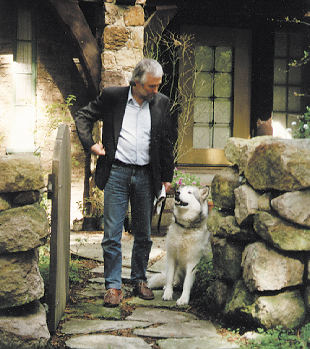
All-or-none reward training is the quintessence — the sine qua non — of successful adult dog training. All-or-none reward training techniques are easy, simple and extremely effective. The techniques have similarities to clicker training in that no commands are given and the dogs are neither lured nor prompted. However, all-or-none reward training is much quicker than clicker training since shaping is unnecessary. Within just a few minutes, without giving a single instruction, your dog will learn to pay attention, not to touch forbidden food and objects, sit stay and to walk calmly on leash. And once all-or-none reward training techniques give you back your dog’s attention, you can go back to using the lightning-fast, lure/reward training techniques that you used with your puppy.
Good Behavior
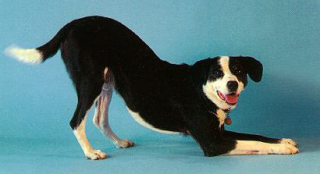
Taking the good for granted and moaning and groaning about the bad is without a doubt, our biggest human foible. Rather than relishing all wonderful things about life, we tend to focus on problems. This tendency is extreme when people interact with their family, friends, colleagues, dogs and horses, and especially when people evaluate their own lives.
For years and years, dog training was almost entirely problem-based. People would offer limited supervision and instruction to their dogs and them punish them whenever they broke rules that they didn’t even know existed. Yet, if we objectively time-sample behavior, we find that even very badly behaved (uneducated) dogs (and people) are actually good most of the time. For example, observe your dog for half an hour and every two minutes or so ask the simple question, “Is he being good or bad?” You will find that he is being good well over 90% of the time. But in the normal course of the day, most of a dog’s good behaviors are ignored. Instead owners are more likely to pay attention to the dog when he barks, or when he steals, chews or runs away with inappropriate articles. So much so in fact, that many dogs quickly learn that misbehaving is the very best way to get their owners attention. Indeed, many dogs will bark, steal, chew and run away with inappropriate articles simply to get their owners to respond or at least acknowledge their existence.
Dogs are social animals and absolutely thrive on social interaction, communication and feedback regarding the appropriateness of their behaviors. Dogs need oodles and oodles of attention (and affection), so lets give it to them when they are good.
One of the most magically powerful training techniques is to ignore all unwanted and inappropriate behavior and instead, to pay attention to and reinforce good behaviors.
Observe your dog and whenever he does something you like, simply say, “Good dog” and give him a piece of kibble. For example, reward your dog whenever he sits, lies down, stops whining/barking/howling/growling (shushes), stops jumping (four on the floor), looks at you, or looks cute.
Unwanted behavior offers a wonderful dog training opportunity because now owners may reward their dog for ceasing undesirable behavior. Reinforcing the cessation of misbehavior is the training technique of choice when trying to eliminate whining, growling and running away, because punishment would only exacerbate the problem, making the dog more likely to whine, growl and run away.
Similarly, rewarding a dog for the absence of misbehavior is an extremely effective training technique. Sometimes the dog may look like he isn’t doing much. But that’s precisely the point! The dog may just stand there wagging his tail, but just think of all the annoying and worrying things he could have been doing. He could have been barking, snarling, snapping, or biting! So, let’s reward dogs for not acting fearfully or antisocially.
Or, you might decide to actively reward your dog for any sociable, friendly or appeasing behavior, such as when he approaches, wags his tail, wags his butt, sticks out his tongue, raises a paw, play bows, or rhythmically shifts his weight back and forth from front paw to front paw.
Obviously, simply ignoring unwanted behavior will not cause it to be eliminated entirely, but you will see a speedy and dramatic reduction in the frequency of undesirable behavior because the dog now allocates most of his time for good behaviors, which are successful in soliciting the owner’s attention and affection, and so there is simply no time for bad behavior. After just a couple of dozen rewards, you will find that your dog is sitting and looking up at you — a perfect sit-stay and perfect unwavering attention. And you didn’t ask for a thing. All you said was, “Thank you!”
In this section, I have sometimes used the words “good” and “bad” to describe behavior. However, it is unlikely that dogs have a solid cognitive grasp on ethics and morality, or even about the concepts of good and bad. Dogs behave (chew, bark, growl, pull on leash, run away etc.) the way they do simply because that’s the way dogs behave and that’s the way owners have trained or allowed the dogs to behave. By “good” behavior, I mean behavior that owners consider to be desirable, appropriate or acceptable and by “bad” behavior, I mean behavior that owners consider to be undesirable, inappropriate or unacceptable
Pay Attention
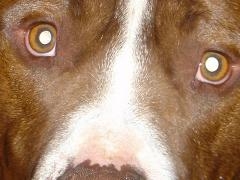
When puppies reach adolescence, food lures temporarily lose effectiveness. The owner and their food lures now have to compete for the dog’s attention with all the more interesting stimuli in the environment. Indeed it is a rude awakening for many owners to discover that their dogs are much more interested in sniffing another dog’s butt or chasing a squirrel than paying attention to them. Most owners resort to upping the olfactory punch (and price) of their food lures. But this seldom works for long. In fact, you may identify forlorn and exasperated owners of adolescent dogs by smell, since they have finally resorted to using dried fish as a lure.
With adolescent dogs we need to temporarily change the type of lure from food to toys. Retrieval toys and tug o’ war toys work the best. Get your dog hooked on fetch or tug and then you may use the toys as lures and rewards to teach him almost anything.
Another approach is to temporarily put food lures aside and to train your dog to pay attention by using all-or-none reward training. Once your dog is paying attention once more, food lure/reward training will work as quickly and as effectively as before.
From simply paying attention to and rewarding your dog for desired behavior as described in the previous exercise, you will find that your dog is much calmer and spends much more time sitting and watching you. This is good. But now we are going to specifically train your dog to pay attention. You may perform this exercise off-leash at home or on-leash on a walk. Rather than feeding your dog from a bowl, weigh out and use his daily allotment of kibble for this and other exercises. Once you have regained your dog’s attention, kibble rewards will be unnecessary and you may feed him how you like. With an attentive dog, your praise will be more than sufficient to further reinforce his attention.
Ignore everything your dog does until he glances at you for an instant. It doesn’t matter how long you have to wait or how short the glance. For the first couple of trials you may have to wait for several minutes but soon you will find your dog will look at you within seconds. As soon as your dog glances at you, say, “Good Dog,” reward him with a piece of kibble and then take one large step (to break his gaze) and wait for him to glance at you again. After a couple of reinforced glances, up the ante in terms of time of attention required for a reward — first one second of attention, then two seconds, three, five, eight, and so on. Count out the time of attention in “good dogs” — “Good dog one. Good dog two. Good dog three, etc.” Once your dog is paying attention for 20 or 30 seconds, you will notice that he is also in a sit-stay.
Now we are going to make it a little more challenging for your dog. After praising and rewarding your dog for looking at you, as you step away, turn your back on your dog to intentionally break his gaze. Give him plenty of time because now he has to work out that staring at your backside is not sufficient, but instead he has to come round in front of you to “find your face.” Praise your dog as soon as he looks up at you and then repeat the sequence.
After a few trials, it’s time to teach your dog to pay attention on cue. Say, “Watch me,” turn away from your dog and praise him as soon as he makes eye contact. Now you will be able to perform this attention exercise in motion by asking your dog to “Watch” while you serpentine backwards away from your dog. Alternatively, ask your dog to watch you while heeling, or during sit-, down- and stand-stays.
Sit-Stay & Walk On-Leash
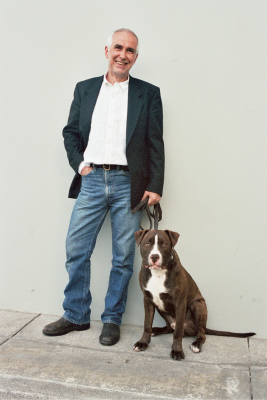
This is one of my all-time favorite training exercises — simply scary in simplicity and shocking in terms of magical results. This exercise actually provides the secret information that some gawdy websites promise over and over but never actually deliver. Watch our videos and see for yourself.
You start with an over-the-top, Iditarod-level leash-puller, who hasn’t paid attention to you for months, or years, and after just ten minutes fun training, you recreate your attentive dog who walks calmly on leash, looks up at you when you slow down and automatically sit-stays when you stop.
Until such a time as your dog is trained to your satisfaction, weigh out and use your dog’s daily allotment of kibble for this and other exercises. You may perform this exercise at home (indoors or outdoors) or on a walk.
Stand still, holding the leash in one hand and kibble in the other with both hands held high up and close to the body. Ignore everything your dog does until he sits. It doesn’t matter how long it takes. Eventually, your dog will sit. Many dogs will go through an entire repertoire of behaviors that worked in the past to make you walk. The dog may lunge into the leash, bark, circle and jump-up. Just stand still and ignore your dog’s unwanted antics. Wait for your dog to sit.
The longer your dog takes to sit, the better he learns that his previous attention-getting and leash-pulling antics no longer work. When he eventually sits and receives immediate praise and a piece of kibble, he will have a Eureka-experience. “Ahhhh! So sitting is the secret to get my owner to move forwards.”
As soon as your dog sits, immediately say, "Good dog," offer a food treat, and then take one huge step, stand still and wait for your dog to sit again. Your dog will likely explode to the end of the leash, thereby illustrating the reinforcing nature of you taking just one step. Wait for your dog to sit again. Most likely he will not take as long this time. When your dog sits, praise, offer a piece of kibble, take one big step and stand still once more. Repeat this sequence until your dog moves forward calmly (because he knows you are only going to take one step) and sits promptly when you stop and stand still.
Your dog has now learned he has the power to make you stop and the power to make you go. If he tightens the leash, or bounces and barks like the proverbial banana, you stop. But if he slackens the tension on the leash and sits, you take a step. After a series of single steps and standstills without pulling, try taking two steps at a time. Then go for three steps, then five, eight, twelve, and so on. Now you will find your dog will walk attentively on a loose leash and sit automatically whenever you stop. And the only words you have said were "Good dog."
Occasionally, stand still and delay giving the kibble for longer and longer periods. Praise your dog as he remains looking up at you in a sit-stay. Count out the length of the sit-stay in “good dogs”—“Good dog one. Good dog two. Good dog three, etc.”
Now we are going to teach the dog to walk by your left side. Repeat the one-step-and-sit sequence as before but this time, when you take the one big step, rotate clockwise or counterclockwise through 90, 180, or 270 degrees and stand still and wait for your dog to sit by your left side. (If you would like to walk your dog on your right side, that’s perfectly OK. Most trainers teach dogs to walk on the left.) Once your dog sits reliably by your left side each time you stop, start to thin out the food rewards and only reward the dog for straighter sits. Gradually and progressively increase the number of steps you take with each repetition. Now your dog is heeling when you walk and automatically sitting when you stop.
Alternate heeling and walking on-leash. For most of the walk, let your dog range and sniff on a loose leash, but every 25 yards or so, have your dog sit, heel, and sit, and then walk on again. Always sit-heel-sit your dog when crossing a street: sit before crossing, heel across, and then sit on the other side of the street.
Housetraining Tip
It is a good idea to have your dog eliminate before beginning a walk. It is so much easier to clean up and dispose of feces close to home. An empty dog will not pee over neighbors’ lawns or cause you to have to complete the walk carrying a plastic baggie of dog doo. To teach your dog to eliminate promptly, leave your house, stand still, instruct your dog, “Go pee, go poop,” and wait. When your dog pees, praise and offer kibble. Increase the length and enthusiasm of praise and the number of pieces of kibble according to the length of the pee. No praise for quick pretend pees, a “good dog” and a single piece of kibble for a two-second pee, “gooood dog” and two pieces of kibble for a three-second pee, etc. When your dog poops, celebrate with songs of praise and treats and say, “Walkies!” If your dog does not poop within three minutes, go back inside and walk your dog half an hour later. With a simple “no-poop-no walk” policy, you’ll soon have the speediest defecator on the planet.
Off & Take it
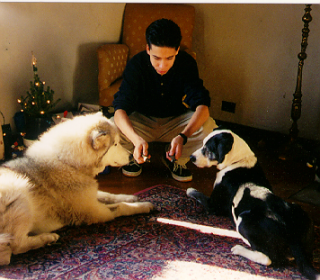
A major criticism of using food in training is that the dog may become over excited, worry at the food, or even bite the hand that feeds it. However, the use of food is indispensable for classical conditioning, temperament training and behavior modification. Also using food and toy lures and rewards just makes teaching basic manners easier, quicker and just so much more fun for owners. Even so, food is used only initially to teach the dog what we want him to do. Once the dog learns the meaning of our handsignals and verbal instructions, food is no longer necessary as a lure. Also, we want to phase out food rewards and replace them with more meaningful Life Rewards (toys, games, and activities) as quickly as possible. See Food Critics
For the meantime though, we want to teach dogs to pay attention to food in our hands but never to touch, unless requested to “Take it.” The process is simple. Hold a piece of kibble in a clenched fist in front of your dog’s nose and ignore everything your dog does (licking, nibbling, or pawing your hand). Immediately praise your dog the moment he ceases contact with your hand and then say, “Take it” and open your fist so the dog may take the kibble from the palm of your hand. Repeat the sequence several times. After six to eight repetitions, you will find that your dog will quickly pull his muzzle back when you present the kibble in your fist. On subsequent trials, say, “Off,” “Don’t Touch,” or “Leave it” before presenting your fist. Count out the period of non-contact in “good dogs,” and say, “Take it” before presenting the kibble on the palm of your hand. You will also notice your dog is in a sit-stay and looking up at you with great attention.
Teaching “Off” is extremely useful for instructing your dog not to touch all sorts of things, such as, food on the coffee table, food you’re eating, food that children are eating, used-diapers, the baby, a shy dog, the cat, cat feces, or any feces or carrion. Also, by teaching “off” your dog also learns “Take it,” which will facilitate teaching your dog to retrieve and play tug o’ war according to the rules.